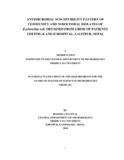Please use this identifier to cite or link to this item:
https://elibrary.tucl.edu.np/handle/123456789/602| Title: | Antimicrobial Susceptibility Pattern Ofcommunity and Nosocomial Isolates of Escherichia Coli,Obtained From Urine of Patientsvisiting Band B Hospital, Lalitpur, Nepal |
| Authors: | Paudyal, Rakshya |
| Keywords: | multi-drug resistance,;Nosocomial;E.coli, |
| Issue Date: | 2010 |
| Publisher: | Central Department of Microbiology |
| Institute Name: | Central Department of Microbiology |
| Level: | Masters |
| Abstract: | The present study was conducted at B and Bhospital,Lalitpur, Nepal during April 2008to April 2009. It was carried out with the objective to isolateEscherichiacoli (E. coli)causing urinary tractinfectionand determine its antimicrobial resistance trend. Antimicrobial susceptibility to 16 antibiotics was determined for 555 E. coli isolatesobtained from both community and hospitalized patients in B and B hospital followingModified Kirby Bauer disc diffusion method. Carbapenems (Imipenem and Meropenem) were the most effective antibiotics (90%susceptible) followed by Cefoperazone sulbactam (84.3%). Similarly, Nitrofurantoin(75.5%) and Amikacin(74%) were the most active agents among the empirically usedantibiotics. High percentage of resistance to Amoxicillin (77.4%), Nalidixic acid(71.4%), and Cotrimoxazole (67.2%) were observed in both sets of community andnosocomial isolates. Isolates exhibiting resistance to multiple drug classes were high(70.1%)which wereeven higher in case of nosocomial isolates(90.5%) than in Community isolates(62.7%)which was also proven to be statistically significant (p<0.05).Similarly highmulti drugresistant (MDR) strains were isolated fromchildren (<16 years) than that from adults(≥16 years) where the association was again statistically significant(p<0.05). Among only the MDR isolates,97.7%, 96.4%, 88.2% and87.4% of the isolates wereresistant toNalidixic acid,Amoxicillin,CepahlexinandCotrimoxazolerespectively. With the exception of Carbapenems, Cefoperazone Sulbactam, Amikacin andNitrofurantoin, resistance to commonly used empirical oral treatments for Urinary tractinfection (UTI)was extremely high. Levels of resistance toAmoxicillinandNalidixicacidrender them unsuitable for empirical use. Thereforea continuous investigation andsurveillance in larger area is required for the effective treatment of both community andnosocomial UTI. Keywords: E.coli, urinary tract infection (UTI), multi-drug resistance, Community,Nosocomial. |
| URI: | http://elibrary.tucl.edu.np/handle/123456789/602 |
| Appears in Collections: | Microbiology |
Files in This Item:
| File | Description | Size | Format | |
|---|---|---|---|---|
| COVER.pdf | 37.58 kB | Adobe PDF |  View/Open | |
| CHAPTER.pdf | 401.25 kB | Adobe PDF |  View/Open |
Items in DSpace are protected by copyright, with all rights reserved, unless otherwise indicated.
